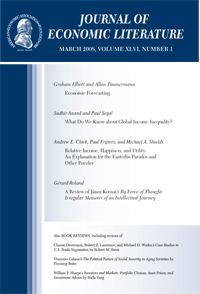全球基础设施差距:潜力、危险和区分框架
IF 10.6
1区 经济学
Q1 ECONOMICS
引用次数: 1
摘要
2015 年,世界银行声称富国私人资本可以(i)缩小穷国的基础设施服务差距,(ii)实现可持续发展目标,(iii)通过对穷国基础设施从 "数十亿到数万亿 "的投资赚钱。我们的框架区分了世界银行的主张在哪些穷国站得住脚,哪些站不住脚。对于某个贫困国家而言,该框架显示,如果基础设施的社会回报率通过了两道关卡:(a)贫困国家私人资本的社会回报率,以及(b)富裕国家私人资本的社会回报率,那么在基础设施上投资一美元就是有效的。将该框架应用于基础设施社会回报率的唯一综合性跨国数据集表明,1985 年,在 53 个穷国中,仅有 7 个国家在铺设道路和电力方面跨越了双重障碍。(JEL H43, H54, L94, O13, O18, Q01)本文章由计算机程序翻译,如有差异,请以英文原文为准。
The Global Infrastructure Gap: Potential, Perils, and a Framework for Distinction
In 2015, the World Bank claimed that rich-country private capital could: (i) close the infrastructure services gap in poor countries, (ii) achieve the sustainable development goals, and (iii) make money by moving from “billions to trillions” of investment in poor-country infrastructure. Our framework distinguishes those poor countries in which the Bank’s claim is tenable from those where it is not. For a given poor country, the framework reveals that investing a dollar in infrastructure is efficient if the social rate of return on infrastructure clears two hurdles: (a) the social rate of return on private capital in the poor country, and (b) the social rate of return on private capital in rich countries. Applying the framework to the only comprehensive, cross-country dataset of social rates of return on infrastructure indicates that in 1985 just 7 of 53 poor countries cleared the dual hurdles in both paved roads and electricity. (JEL H43, H54, L94, O13, O18, Q01)
求助全文
通过发布文献求助,成功后即可免费获取论文全文。
去求助
来源期刊

Journal of Economic Literature
ECONOMICS-
CiteScore
17.80
自引率
0.80%
发文量
49
期刊介绍:
Commencing in 1969, the Journal of Economic Literature (JEL) serves as a vital resource for economists, offering a means to stay informed about the extensive literature in the field. Each JEL issue features commissioned, peer-reviewed survey and review articles, book reviews, an annotated bibliography categorizing new books by subject, and an annual index of dissertations from North American universities.
 求助内容:
求助内容: 应助结果提醒方式:
应助结果提醒方式:


